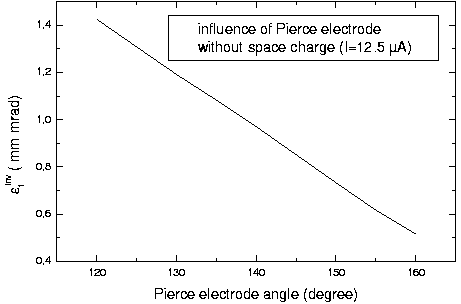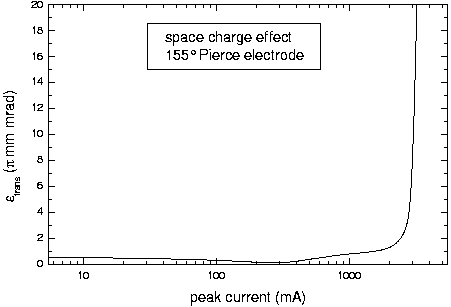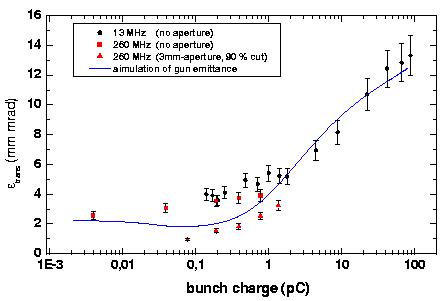|
Recently the injector beam parameters of the superconducting electron linear
accelerator [1] were measured. For the transverse emittance an increase with
bunch charge was found [2]. It grows from about 2 mm mrad for low bunch
charges to nearly 14 mm mrad at a bunch charge of 85 pC. More detailed
studies showed that this behaviour was rather independent of the injector
operating parameters (bunching, pulse repetition rate) and that the
emittance growth already takes place in the electron gun. The electron gun
is a thermionic triode type with 250 kV cathode voltage and two-step
acceleration. The gun has a cathode of 8 mm diameter and a 200 mm grid
about 150 mm in front of it. By means of the grid, electron pulses are
formed with either 13 or 260 MHz and a pulse length of about 600 ps. The
maximum peak current is 140 mA which corresponds to a bunch charge of 77 pC
and an averaged current of 1 mA at 13 MHz.
Numerical simulations were performed in order to understand the increase of
the transverse emittance with bunch charge. Possible reasons which may cause
the emittance growth and are considered within the simulations are: the
thermal energy spread of the electrons, influence of the electrostatic
accelerating field formed by the electrodes (geometrical aberrations), space
charge effects, and the influence of the control mesh. For the calculations
the program EGUN [2] was used.
As an example of the electrode geometry effect, Fig. 1 shows the influence
of the Pierce electrode angle on the transverse emittance. It can be seen
that the emittance decreases if the angle is increased. But this result is
independent of the bunch charge and the emittance values are always much
lower than the measured ones. The space charge effect is presented in Fig. 2
which shows the transverse emittance as function of the peak electron
current. A significant effect on the transverse emittance is found for peak
currents higher than about 1 A.

Fig. 1 Transverse emittance (RMS) as a function of Pierce electrode angle.
The control grid is a source of emittance growth because the strong
acceleration field penetrates through the mesh holes, and for the electrons
each hole acts as a lens. In order to estimate this effect a formula was
derived by Reiser [4]. But this formula cannot be applied in the present
case where the mesh is always on negative potential. Therefore the grid
effect was studied numerically by modifying the GUN code. For the electron
transmission through the potential barrier of the mesh the free electron gas
approximation with a local penetration probability , a Maxwell energy
distribution, and Lambert's law were applied. Although the model is rather
simple and stationary calculation with circular mesh holes are performed,
the experimental results are well described by the calculation, as can be
seen in Fig. 3. Thus, it can be assumed that the emittance growth is mainly
caused by the grid. Furthermore the computer simulation predicts that
smaller transverse emittance can be obtained at the ELBE injector by means
of a smaller cathode diameter or/and a finer control mesh.

Fig. 2 Transverse emittance (RMS) as a function of peak current (space charge effect).
Fig. 3 Transverse emittance (RMS) as a function of bunch charge measured at the ELBE injector for 13 and 260 MHz pulse repetition rate and with an additional aperture. The curve presents the calculation result of the grid effect. References
[1] F. Gabriel et al., Nucl. Instr. Meth. B 161-163 (2000) 1143
|
